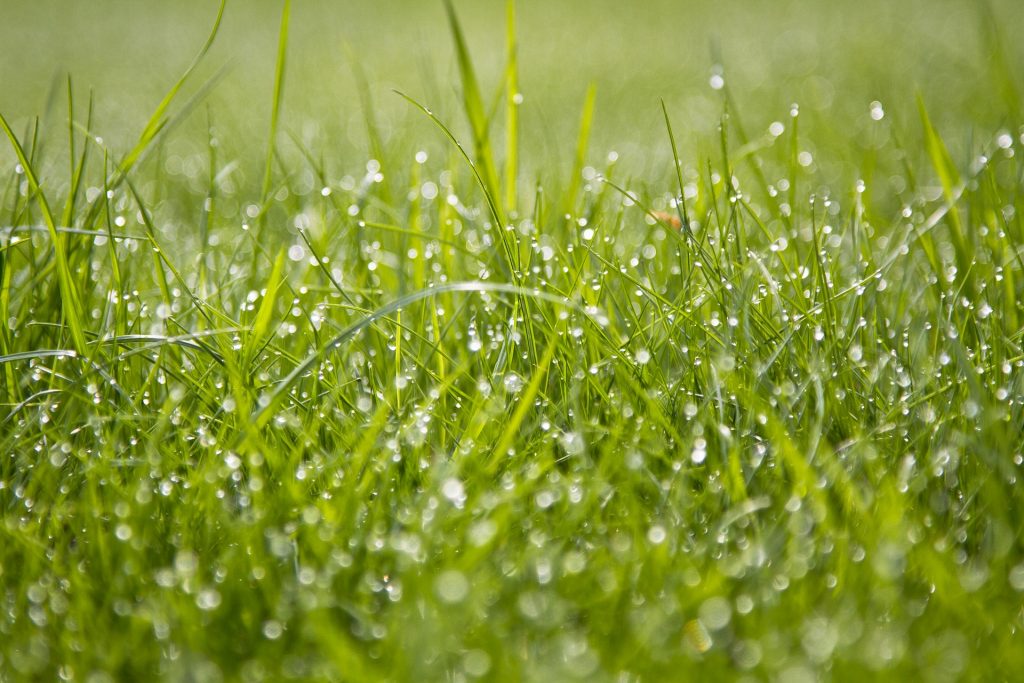
Today more than ever, homeowners are thinking about how to maintain a sustainable lawn. It should come as no surprise that the traditional turf lawn does no favors to the environment. In the eastern part of the United States, 30% of all water use goes to irrigating residential lawns. On the west coast, that number jumps to 60%. Imagine that! Two of every three gallons of water consumed on the west coast are spent keeping someone’s lawn green through the hot summer months.
We often think of pesticides and pollution as primarily a concern for commercial farmers. But did you know that the average residential lawn gets ten times as much chemical pesticide as a commercial farm?
And keeping those lawns neatly trimmed pumps out vast amounts of pollution from burning fossil fuels. A gas mower gives off as much as 12 times as much hydrocarbon as the average car. A weed eater gives off 21 times the average exhaust of a motor vehicle. And gas-powered leaf blower exhaust clocks in at a whopping 3,400% of typical vehicle exhaust!
With so much at stake, it’s no wonder many homeowners are looking for more sustainable alternatives. We all want that perfectly thick green lawn. But no one wants to damage the planet in the process. Luckily, there are some simple tips that can make your lawn more sustainable. And you don’t have to sacrifice the quality of your lawn to do it.
![7 Tips for a Sustainable Lawn [infographic]](https://theturfgrassgroup.com//wp-content/uploads/2020/03/7-Tips-for-a-Sustainable-Lawn-infographic.jpg)
1. Work from the Ground Up
A sustainable lawn starts with healthy soil. If your soil is in poor condition, you’ll never get that beautiful lawn you’re pining for. So how do you keep your soil healthy? A good place to start is with a simple pH test, so you know what your starting point is. You can get a soil pH test at any nursery for around $15. The ideal pH for your lawn’s soil is between 6.5 and 7. That’s slightly acidic and perfect for healthy turf. If your soil is too acidic, you can sprinkle on some lime to raise the pH a bit. If your pH is too high, adding sulfur can bring it down to that 6.5-7 range.
Another aspect of soil health is the makeup of your soil. You want a good, lightly compacted mixture of clay, sand, and organic hummus or silt. If your soil has too much clay, your turf won’t be able to get the nutrients it needs. In that case, aerating your lawn will help loosen the soil. If you’re lacking in organic matter, you can spread around some organic compost. For an even easier organic nutrient boost, don’t collect your lawn clippings when you mow. Instead, let the clippings stay on the lawn. It will reduce your landfill input, and the clippings will decompose to return their nutrients to the soil.
2. Grow the Right Grass for Your Climate
One mistake that many homeowners make is choosing the wrong type of turf for the local climate. If you have the wrong sod variety, you will be in a constant battle with the weather. That could lead to wasted water, too much fertilizer, and overuse of herbicides.
Here in the Southeast, TifTuf Bermudagrass is an ideal cultivar. TifTuf Bermudagrass is a warm-weather grass that stands up well to drought conditions and heavy traffic. It makes good use of the water it gets and grows strong, deep roots. If you leave outside the Southeast, read up on our varieties to learn more about the perfect turf variety for your climate.
3. Aerate Your Sustainable Lawn When Necessary
Sticking with that ground-up principle, make sure that you aerate when necessary. An aerator pulls out finger-sized plugs of dirt from your lawn. Aerating can loosen compacted soil and provide your turf’s roots with better access to sun, water, air, and nutrients. Aerating can be stressful for your lawn, so don’t overdo it. But aerating twice a year, in the spring and fall, can help keep your soil and your lawn healthy.
Right after you aerate is also a perfect time to fertilize your lawn. The holes in the soil give the roots better access to the fertilizer, and you can avoid runoff from excess fertilizer. And speaking of runoff, compacted soil leads to more puddling and runoff when water isn’t adequately absorbed into the soil. Even one inch of water—the recommended amount—can cause pooling and runoff. Pooling is damaging to your grass. It can literally drown the grass, or suffocate it. And runoff is a waste of water that can also pollute waterways. Avoid pooling and runoff by aerating at least once a year.
Aerating also improves soil health. When your aerator pulls up plugs of dirt, it also deposits beneficial microorganisms on top of the soil. Those organisms can break down thatch and grass clipping to create a healthy hummus layer.
4. Mow for a Sustainable Lawn
Many homeowners don’t pay much attention to the details of lawn mowing. They are content to wait until their lawns look shaggy and then go out and trim the turf back to a reasonable height. But growing a sustainable lawn means thinking a little more about how you mow. First, mow more often than you think. During the peak growing months from late spring to the end of summer, mow once a week. The key is to mow often enough that you never take off more than one-third of the height of the grass. Cut more, and you may stress the grass and leave it less healthy.
Keeping your grass at its maximum recommended height will also help retard weed growth and maintain the soil. When grass is longer, it keeps the soil shaded, so it doesn’t dry out. It also crowds out weeds without any additional herbicides. For TifTuf Bermudagrass, the recommended height is two inches for most residential lawns.
5. Don’t Burn Fossil Fuels
Another way to maintain a sustainable lawn is to avoid pollution from mowing. Remember that statistic about exhaust from gas mowers? They put out 10 to 12 times the emissions of the average motor vehicle. But there is a better alternative: manual reel mowers.
When you imagine a manual reel mower, you probably think of some poor teenager sweating as they struggle to run a mower across an overgrown lawn. But technology has come a long way. Modern reel mowers are much lighter. They are made with more durable blades that effortlessly slice through tall grass. Many reel mowers use hardened steel blades that can go for a decade before they need sharpening. You won’t create any exhaust, and you may get a bit of a workout, too. Another benefit is the way a rotary mower cuts your grass. Many gas mowers rip the top off your grass. A reel mower gives a cleaner slice, snipping the grass like scissors, reducing stress to your lawn. That’s why professionally manicured lawns often use reel mowers pulled by tractors.
If a reel mower is too much work, consider an electric mower. Of course, the electricity has to come from somewhere, but an electric mower still puts off far less exhaust than a gas mower. And modern electric mowers are also much softer than a roaring gas engine.
6. Don’t Waste Water On a Sustainable Lawn
As we said above, 30-60% of all domestic water use is used to irrigate lawns. That’s a tremendous amount of water. But there’s a silver lining in that number. If we can reduce the water used for lawns, we can make a huge dent in domestic water use overall.
To do your part, make sure that you aren’t overwatering your turf lawn. Most mature turf, including TifTuf Bermudagrass, only needs one inch of water a week. And it doesn’t matter where that water comes from. So if it rained this week, or if it is forecast to rain, skip your irrigation. You can try to manage your irrigation schedule manually. But an easier method is to invest in a smart irrigation system. A smart irrigation system is hooked up to the internet and waters based on the weather forecast. If it looks like rain, it will skip that week’s watering.
Another way to get the most out of your irrigation is to water in two sessions. Give your lawn a half-inch and then wait for that to soak in before irrigating another half inch. An easy way to tell how long it takes your irrigation system to water a half-inch is to place a few cups around your yard. Mark each cup at a half-inch, then check the cups to see when, on average, they reach the mark. That will tell you how long to water.
Make sure to water in the morning before the full heat of the day has kicked in. That will reduce evaporation and maximize water use.
7. Use Paths Instead of Grass for Heavily-Trafficked Areas
We know, this was supposed to be about a sustainable lawn, not hardscaping. But the fact remains that areas with the most foot traffic can cause the biggest headaches. Foot traffic can lead to compacted soil, trampled grass, and even ditches worn into the ground. The effort to revive that turf leads to extra fertilizer and more herbicide as weeds flourish. Compacted soil can lead to puddling and runoff, which pollutes the waterways that storm drains empty into. And there’s not much to do when just one patch of soil is overly compacted. Usually, you aerate your whole lawn all at once.
For all these reasons, if you have an area that gets a lot of foot traffic, you may be best off replacing it with a path. A gravel path is relatively cheap to install and low maintenance, though it may need a little weeding. Laying out paving stones or a few stepping stones is very low maintenance, although the initial costs are a little higher. Basically, anything you can do to eliminate high-traffic, high-damage areas will allow you to use more sustainable lawn maintenance practices across your lawn.
The most significant factor in sustainable lawn maintenance is starting with the right turf. Robust and healthy grass can crowd out weeds. It also needs less fertilizer and can sustain drought better. TifTuf Bermudagrass grows deep roots and stays healthy even in drought conditions. If you’re looking for more sustainable lawn maintenance, start with certified TifTuf Bermudagrass. You can find a grower here.
